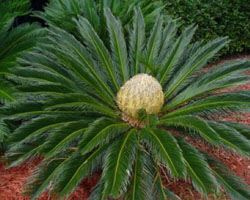Cycas revoluta - King sago



Family Cycadaceae
Description:
Approximately ninety species of Cycas are native to east Africa, Asia, Polynesia and Australia. The king sago is native to Japan. Although it is sometimes called a "sago palm," the king sago is a cycad, a type of gymnosperm. Cycad fossils date back further in time than dinosaur fossils. The king sago bears its seeds in cone-like strobili. Seeds and pollen are borne on separate plants, a condition known to scientists as dioecious. Pollination is at least partly by beetles but the light, airborne pollen may be transferred by wind also. Root nodules, called coralloid roots, contain nitrogen-fixing cyanobacteria.
Location:
See plants at several sites on campus including Alumni Plaza and in front of the library.
Size:
Shrubby plant with trunks up to six feet or more.
Care Instructions:
Light: full sun to part shade
Water: very drought tolerant once established
Soil: well-drained soil, no other special requirements
This is a reliably hardy plant in northeast Florida. A pest introduced to Florida, alaucapsis scale, can kill the king sago and other Cycas species. If this pest can withstand north Florida's winters, it will limit the landscape use of the king sago in Jacksonville.
